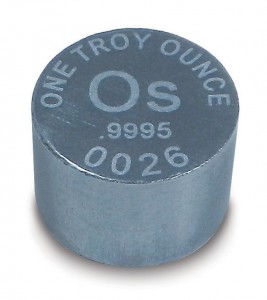Osmium Price
Osmium is one of the platinum group metals (PGM), and it has a blue gray color. It does have certain unique characteristics that differentiate it from the other elements. To begin with, it is the densest of all the naturally occurring elements, as it weighs 22.59 grams per cubic centimeter. In addition, it is also one of the rarest elements, as its abundance in the Earth’s crust is just 0.0018 parts per million. In comparison, gold is 0.0031 parts per million.
It was discovered in 1803 by a British chemist named Smithson Tenant, who obtained samples from W.H. Wollaston, who had discovered platinum. The metal is named for the Greek word for “smell” because it emits a distinct odor when it oxidizes in the air. It actually emits osmium tetroxide when it oxidizes, which is toxic.
It’s found naturally alloyed with iridium, and in deposits of copper and nickel ores it’s also found as a trace element. It’s actually very difficult to make, and each year less than a ton is produced. Its hardness, brittleness and high melting point all make it extremely difficult to form into a desired shape.
Below is the historical Osmium price per troy oz.
| Year | Price | Price (Inflation Adjusted) | Change |
|---|---|---|---|
| 2012 | $400.00 | $442.49 | 0% |
| 2013 | $400.00 | $435.95 | 0% |
| 2014 | $400.00 | $429.09 | 0% |
| 2015 | $400.00 | $428.66 | 0% |
| 2016 | $400.00 | $419.02 | 0% |
| 2017 | $400.00 | $409.60 | 0% |
| 2018 | $400.00 | $400.00 | 0% |
Price History of Osmium
In the global market, it is usually traded as part of the platinum group metals. On its own, it is rarely traded. Theoretically, its price hovers around the $400 per troy ounce mark, and it’s been that way since the start of the 1990s. But that’s not the real price tag. Instead, it’s a starting point for negotiations when a company needs to purchase the metal.
This stagnation in the price is due to the fact that the demand and supply matches up and doesn’t fluctuate. The metal is very rare and only a tiny amount is produced, but then it is very rarely used anyway. It’s for that reason the price has stayed the same for years.
Osmium as Investment
In all honesty, there’s really not that much of a point in investing in this particular metal. It’s simply not a practical option.
- Investors have much better alternative options in the metals market. Even among the other PGMs, you’re much better off investing in palladium or platinum because these metals have robust financial markets.
- It’s all about the volume of the trading. Trading in a company that only has 10 shares doesn’t make sense, because no trading occurs when none of the 10 shareholders wish to sell their shares to someone else. It makes more sense to trade in a company with a million shares with numerous shareholders, because the shares are constantly traded each day. It’s the same thing with osmium. The industry only uses a very small amount for specialized purposes, so investors don’t have much of a chance to participate.
- You can store bullion gold, but you can’t do the same for osmium. It’s toxic, so storage becomes a huge problem.
Purposes Used For

It’s very rarely used in its pure state, because it is too volatile and too toxic. Instead, it is almost always used as part of a metal alloy. Since this metal is very dense, it is suitable for uses that come with high wear.
The alloys that contain this element are usually used for various applications where friction must be minimized. Historically, these devices include the tips of fountain pens and ball point pens, record player needles, instrument pivots, compass needles, and electrical contacts.
The toxic osmium tetroxide compound is actually quite useful, although of course the people who handle it must take appropriate precautions. It is used to stain biological
samples before they’re inspected under a microscope. It stabilizes biological membranes in tissue samples, and using the metal for staining significantly improves the image contrast.
It has also demonstrated a very high reflectivity in the UV range of the electromagnetic spectrum, and in certain instances it is even twice as reflective as gold. It’s been used in mirrors for UV spectrometers in space, although in low space orbit there were still enough oxygen deteriorate the metal.
Surprisingly, the toxic osmium tetroxide compound even has some clinical uses. In Scandinavia, it’s been tried out for patients with arthritis and early results indicate that the metal itself may be biocompatible. In 2011, a study showed that the metal also demonstrated some anticancer activity, and it may be part of some anticancer treatments in the future.
But that’s the future. Today, it must be accepted that the supply of the metal is too little, that it is too difficult to work with, and it has very few applications for which there isn’t a more suitable (and much safer) alternative element to use. It’s not really a practical metal to deal with, either in industry or in trading.
